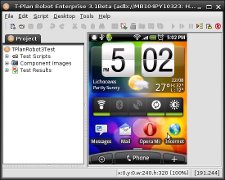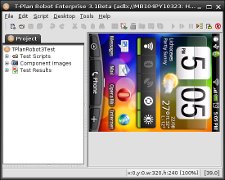| T-Plan Robot Enterprise
3.4.2 Doc
Collection |
02/09/13 |
| Automation
over ADB |
Automation
over VNC |
| +
The
device
doesn't
have
to
be
rooted |
-
DroidVNC:
The
device
must
be
rooted + VMLite VNC: The device doesn't have to be rooted |
| +
Good
support
across
devices
and
Android
OS
versions |
+ Good support across devices
and Android OS versions |
| +
No
SW
installation
on
the
device
required |
-
The
device
must
have
the
VNC
server
installed
&
started |
| + Good support of the Android native keys | - Limited support of the Android native keys |
| - Slower screen
refresh
rate for large screen devices due to lack of image compression in the Android SDK |
+ Good screen
refresh rate for large
screen
devices (depends on the preferred image encoding) |
| + Support of both automatic and manual
screen rotation |
- Manual screen rotation only
supported |
<SDK_path>/tools/android
tool.adb.exe
to the user or
system path:adb.exe to the
beginning of the list. To separate the path from the original
value use semicolon, ';'.
The new
value should look like: <SDK_path>\platform-tools;<originalPaths> "adb devices" from the platform-tools/
folder of your Android SDK. Alternatively leave the field on "default"
to
connect to the first detected device.platform-tools
folder under the Android SDK installation path.adb kill-serveradb
devices
Connect adb://default Java test
scripts: connect("adb://default");
Connect adb://MB104PY10519 Java test
scripts: connect("adb://MB104PY10519");  |
|
 |
| Correct
view |
Incorrect
view Search for components using the image comparison will not work and the touch screen events will be misplaced. |
| Device
Action |
Computer Action |
Test Script Action |
| Tap
(touch) |
Left
mouse
click |
Call the Mouse click command (TPR scripts) or one of the mouseClick() methods (Java scripts). |
| Long
tap (touch) |
Long
left mouse click |
Call a
sequence
of Mouse press, Wait and Mouse release
commands or the
corresponding Java methods. |
| Swipe (drag) | Mouse
drag
(left
button
down) |
Call the Mouse drag command (TPR scripts) or one of the mouseDrag() methods (Java scripts). |
| Pinch
(zooming
with
2
fingers) |
Not
supported |
Not supported |
| Back |
Right
mouse
click |
Call
the Mouse click btn=right
command (TPR scripts) or one of the mouseRightClick()
methods (Java scripts). Alternatively use "Press Back" or press("Back"). |
Press Alt+Z"
generates
the Euro character on some devices. These composed
keys are subject to the device, its language and keyboard
settings
and they must be explored per device.| Android
Device
Key |
Computer/Script
Key
(Action) |
Description |
| BACK |
Escape,
Right
mouse
click |
Back key. |
| CALL |
PageDown |
Call key. |
| CAMERA |
F6 |
Camera key. Used to launch a camera application or take pictures. |
| CLEAR |
F7 |
Clear key. |
| DEL |
Backspace |
Backspace key. Deletes characters before the insertion point. |
| DPAD_DOWN |
Down
(Arrow Down), Mouse wheel down |
Directional Pad Down key. May also be synthesized from trackball motions. |
| DPAD_LEFT |
Left
(Arrow Left) |
Directional Pad Left key. May also be synthesized from trackball motions. |
| DPAD_RIGHT |
Right
(Arrow
Right) |
Directional Pad Right key. May also be synthesized from trackball motions. |
| DPAD_UP | Up
(Arrow
Up),
Mouse
wheel
up |
Directional Pad Up key. May also be synthesized from trackball motions. |
| ENDCALL |
End |
End Call key. |
| FOCUS | F5 |
Camera Focus key. Used to focus the camera. |
| HOME |
Home |
Home key. This key is handled by the framework and is never delivered to applications. |
| MENU |
PageUp |
Menu key. |
| NOTIFICATION |
F9 |
Notification
key.
Used
to
display
the
list
of
notifications. |
| POWER |
F10 |
Power
key. |
| SEARCH |
F3 |
Search key. |
| SOFT_LEFT |
F1 |
Soft
Left
key.
Usually
situated
below
the
display
on
phones
and
used
as
a multi-function feature key for selecting a software defined function shown on the bottom left of the display. |
| SOFT_RIGHT |
F2 |
Soft
Right
key.
Usually
situated
below
the
display
on
phones
and
used
as
a multi-function feature key for selecting a software defined function shown on the bottom right of the display. |
| SYM |
F8 |
Symbol
modifier
key.
Used
to
enter
alternate
symbols. On most devices it pops up the "Select input method" window. |
| VOLUME_DOWN | F11 |
Volume Down key. Adjusts the speaker volume down. |
| VOLUME_UP | F12 |
Volume Up key. Adjusts the speaker volume up. |